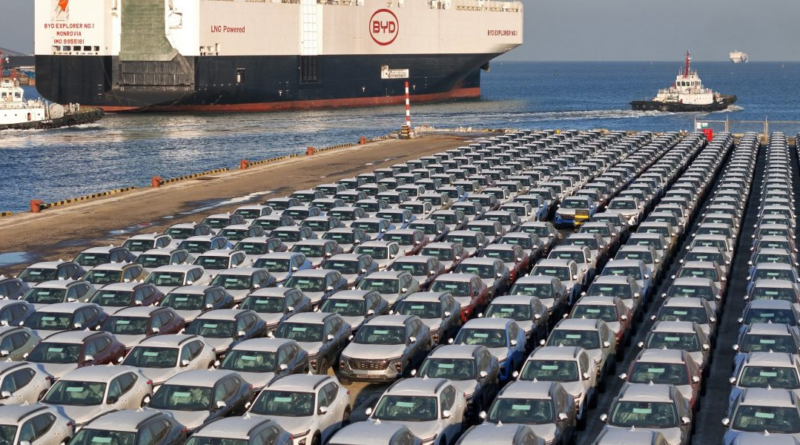BYD is coming for Europe—but it won't be easy
If you asked the typical European or American about BYD a couple of years ago, only the biggest petrol-head or an astute follower of Warren Buffett’s portfolio could have given you a confident answer on what the company does.
It’s taken a brutal price war with Elon Musk and an ascension to the top of the Chinese car pyramid to change that. Now that it’s left competitors in a “state of shock,” BYD has become hard to ignore.
However, as BYD fights a declining share price, Europe’s automakers have a few reasons to be optimistic that they will fare better in a battle on home soil.
BYD’s march into Europe
Carmakers hoping to maintain their market dominance while shifting to EVs have obvious cause for concern from BYD.
The carmaker has conquered the Chinese market thanks to its ultra-low prices, fending off an attempt by Musk to encroach on market share through a massive Shanghai production plant and price cuts.
The “Tesla-killer”—with its entry-level Seagull model priced at $11,000—has been able to keep prices so low thanks to its control of its entire EV battery system. This has allowed it to keep prices about 40% below competitors.
That’s a big deal for Europe’s EV-hungry customers. A recent survey by Bloomberg Intelligence found 83% of Europeans saw EV prices as “too high.”
“BYD has been more focused on the affordable mass market, which could be attractive for buyers in the European market amid high interest rates and subsidy cuts,” Nishita Aggarwal, an automotive industry analyst at the Economist Intelligence Unit, told Fortune.
Increasingly BYD, which currently has a small presence in Europe, is putting its vast resources into placing itself on the continent.
The group plans to build a production factory in Hungary, while earlier in January it started using purpose-built cargo ships to send its EVs to Europe.
In May, an Allianz Trade report put a figure on the Chinese automaker’s potential damage.
The study suggested China posed the greatest risk to Europe’s automotive sector and could cost them €7 billion ($7.7 billion) in annual profits by 2030.
BYD didn’t immediately respond to Fortune’s request for comment.
Pricing controversy
However, you only need to look as far as BYD’s share price to find weak spots in the group’s tough exterior.
Despite increasing deliveries, BYD has fallen more than 16% in value over the last 12 months.
Buffett’s Berkshire Hathaway, the group’s largest investor, has been shedding its stake in the company for several years.
There might be a few reasons for the fall, one being how much European regulators appear willing to defend native automakers at the expense of the price paid by the consumer, and possibly environmental goals.
EU regulators have launched an investigation into Chinese subsidies for its automakers, and how those are filtering through to the price paid by European drivers.
In September, European Commission President Ursula von der Leyen said that Chinese EVs were “distorting our market” thanks to long-running state subsidies.
Calls for a response from the West are getting louder too.
On Tesla’s earnings call Wednesday, Musk said trade barriers were the only thing stopping Chinese EV makers from demolishing its competitors.
Higher import tariffs or fines would blunt BYD’s pricing strength, perhaps enough to reduce its appeal against European competitors.
While Chinese EV makers like BYD are building production facilities in Europe to head off the potential impact of tariffs on its prices, that’s likely to bring fresh obstacles.
Felipe Munoz, a global analyst at JATO Dynamics, says that any moves BYD makes to reduce import charges by offshoring production could be offset by higher labor costs on the continent.
A Reuters analysis of job adverts for 30 automotive groups found hourly salaries in China ranged from $1.93 to $4.27. BYD can expect to pay its European workers significantly more when it sets up shop on the continent.
“Sooner or later, BYD will need to produce vehicles outside of China. By doing so, it risks reducing its competitive advantage,” Munoz said.
Brand loyalty
Just as BYD has been able to propel itself to the top of the pile in its native China, European carmakers have consistently been able to trade on the brand loyalty of customers who have grown up with their vehicles for generations.
If Tesla’s strategy is anything to go by, the new target demographic—now that EV nerds have bought their cars—is likely to be those everyday customers who have grown up with gas-powered household names.
“When you look at car buying in general, we’re trying get to the next set of EV adopters,” Tesla’s chief financial officer Vaibhav Taneja said during an investor call in October.
While incumbent European carmakers like Volkswagen, Renault, and Mercedes-Benz will have to build new trust for their EVs, they’re likely to start on a much stronger footing than new-to-market BYD.
A September study by Bloomberg Intelligence, reported by Motor Finance, found three in five drivers in Europe were likely to stick with their current brands, while only 17% were expected to switch.
Fabian Brandt, the head of automotive and industrial goods at management consultancy Oliver Wyman said: “I do believe that the credibility and trust that European brands enjoy will help them defend their inventory story against new entrants.
“It’s also very much about local presence and local trusts and dealerships, and all that is relatively hard to build.”
Chinese automakers, meanwhile, face massive reputational damage if the quality of their early offerings doesn’t match up to European drivers’ standards.
“There’s a wariness about buying Chinese products generally,” David Kelly, chief corporate officer of Irish automotive tech unicorn Cubic Telecom, told Fortune.
Connectivity
If BYD can overcome the daunting obstacles of European regulation and stubborn consumer sentiment, it still faces difficulties adapting its affordable cars to the continent’s complicated infrastructure.
Cubic Telecom’s Kelly says BYD’s real struggles will come when it tries to branch out from within Europe, given the digital connectivity issues that come with working across several countries.
Kelly says just like with smartphones, EV drivers have become used to a certain level of connectivity in their cars, and expect it in the cheaper models.
But that’s difficult in a region spanning several different jurisdictions and languages. It could also prove to be an obstacle when a driver wants to charge their car.
“You could be talking in the wider European footprint of 60 different countries,” Kelly says.
Each country has “different sims, different mobile network carriers,” massively complicating rollout compared to China or America, where connectivity is streamlined by a limited number of providers.
“There’s going to be a real challenge for them in scaling,” Kelly said of BYD. He thinks it has already happened with Tesla, where its country-by-country expansion has recently plateaued.
Ultimately, Daniel Kollar, the Shanghai-based head of automotive practice at Intralink, thinks BYD’s eventual success or failure in Europe comes down to two questions.
“Firstly, can BYD convince customers to overcome reservations about purchasing from a Chinese auto brand?
“Secondly, can BYD offer superior value to a diverse range of potential EV consumers compared with its competitors?”
If it can do those, European drivers may get used to having a new car brand dominating its roads.



